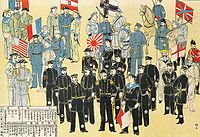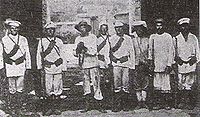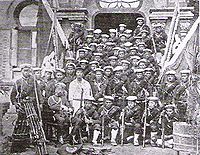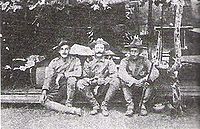
Eight-Nation Alliance
Encyclopedia

Austria-Hungary
Austria-Hungary , more formally known as the Kingdoms and Lands Represented in the Imperial Council and the Lands of the Holy Hungarian Crown of Saint Stephen, was a constitutional monarchic union between the crowns of the Austrian Empire and the Kingdom of Hungary in...
, France
French Third Republic
The French Third Republic was the republican government of France from 1870, when the Second French Empire collapsed due to the French defeat in the Franco-Prussian War, to 1940, when France was overrun by Nazi Germany during World War II, resulting in the German and Italian occupations of France...
, Germany
German Empire
The German Empire refers to Germany during the "Second Reich" period from the unification of Germany and proclamation of Wilhelm I as German Emperor on 18 January 1871, to 1918, when it became a federal republic after defeat in World War I and the abdication of the Emperor, Wilhelm II.The German...
, Italy
Kingdom of Italy (1861–1946)
The Kingdom of Italy was a state forged in 1861 by the unification of Italy under the influence of the Kingdom of Sardinia, which was its legal predecessor state...
, Japan
Empire of Japan
The Empire of Japan is the name of the state of Japan that existed from the Meiji Restoration on 3 January 1868 to the enactment of the post-World War II Constitution of...
, Russia
Russian Empire
The Russian Empire was a state that existed from 1721 until the Russian Revolution of 1917. It was the successor to the Tsardom of Russia and the predecessor of the Soviet Union...
, the United Kingdom
United Kingdom of Great Britain and Ireland
The United Kingdom of Great Britain and Ireland was the formal name of the United Kingdom during the period when what is now the Republic of Ireland formed a part of it....
, and the United States
United States
The United States of America is a federal constitutional republic comprising fifty states and a federal district...
whose military forces intervened in China to suppress the anti-foreign Boxers
Boxer Rebellion
The Boxer Rebellion, also called the Boxer Uprising by some historians or the Righteous Harmony Society Movement in northern China, was a proto-nationalist movement by the "Righteous Harmony Society" , or "Righteous Fists of Harmony" or "Society of Righteous and Harmonious Fists" , in China between...
and relieve the siege of the diplomatic legations in Beijing
Beijing
Beijing , also known as Peking , is the capital of the People's Republic of China and one of the most populous cities in the world, with a population of 19,612,368 as of 2010. The city is the country's political, cultural, and educational center, and home to the headquarters for most of China's...
(Peking).
Events
The Boxers, a peasant movement, had attacked and killed foreign missionaries, nationals, and Chinese Christians across northern China. The Qing government and Imperial Army supported the Boxers and under the Manchu general RongluRonglu
Ronglu was a Manchu statesman and general during the late Qing dynasty. Born into the powerful Guwalgiya clan of the Plain White Banner in the Eight Banners, he was cousin to Yehenara Lan, who later became Empress Dowager Cixi...
, besieged foreign diplomats and civilians taking refuge in the Legation Quarter. After failing in its initial attempt to relieve the Legation Quarter, in August 1900 the Allied force marched to Beijing from Tianjin
Tianjin
' is a metropolis in northern China and one of the five national central cities of the People's Republic of China. It is governed as a direct-controlled municipality, one of four such designations, and is, thus, under direct administration of the central government...
, defeated the Qing Imperial Army Wuwei Troop
Wuwei Troop
Wuwei Troop was the first modern army of the Qing Dynasty consisted of infantry, cavalry and artillery, formed on June 1899 and trained by western military advicers, responsible for security of Peking City and the Forbidden City, with Ronglu as the supreme commander...
in several engagements, and brought an end to the Boxer Rebellion and the siege. The members of the Alliance then occupied Beijing and looted and pillaged the capital.
The forces consisted of approximately 45,000 international troops. At the end of the campaign, the Qing Imperial government signed the Boxer Protocol
Boxer Protocol
The Boxer Protocol was signed on September 7, 1901 between the Qing Empire of China and the Eight-Nation Alliance that had provided military forces plus Belgium, Spain and the Netherlands after China's defeat in the intervention to put down the Boxer Rebellion at the hands of the...
of 1901.
Siege of the International legations
The compound in Beijing remained under siege by the Wuwei Rear TroopWuwei Troop
Wuwei Troop was the first modern army of the Qing Dynasty consisted of infantry, cavalry and artillery, formed on June 1899 and trained by western military advicers, responsible for security of Peking City and the Forbidden City, with Ronglu as the supreme commander...
of the Chinese army and some Yihetuan or Boxers, from 20 June - 14 August. A total of 473 foreign civilians, 409 soldiers from eight countries, and about 3,000 Chinese Christians took refuge in the Legation Quarter. Under the command of the British minister to China, Claude Maxwell MacDonald
Claude Maxwell MacDonald
Colonel Sir Claude Maxwell MacDonald GCMG GCVO KCB PC was a British diplomat, best known for his service in China and Japan.-Biography:...
, the legation staff and security personnel defended the compound with small arms and one old muzzle-loaded cannon discovered and unearthed by Chinese collaborators who turned it over to the allies; it was nicknamed the International Gun because the barrel was British, the carriage was Italian, the shells were Russian, and the crew was American.
Also under siege in Peking was the North Cathedral, the Beitang of the Catholic Church. The Beitang was defended by 43 French and Italian soldiers, 33 foreign Catholic priests and nuns, and about 3,200 Chinese Catholics. The defenders suffered heavy casualties especially from lack of food and Chinese mines exploded in tunnels dug beneath the compound.
Austria-Hungary
The Austro-Hungarian NavyAustro-Hungarian Navy
The Austro-Hungarian Navy was the naval force of Austria-Hungary. Its official name in German was Kaiserliche und Königliche Kriegsmarine , abbreviated as k.u.k. Kriegsmarine....
sent two training ships and the cruisers SMS Kaiserin und Königin Maria Theresia, , , and and a company of marines to the North China coast in April 1900, based at the Russia concession of Port Arthur
Lüshunkou
Lüshunkou is a district in the municipality of Dalian, Liaoning province, China. Also called Lüshun City or Lüshun Port, it was formerly known as both Port Arthur and Ryojun....
.
In June they helped hold the Tianjin
Tianjin
' is a metropolis in northern China and one of the five national central cities of the People's Republic of China. It is governed as a direct-controlled municipality, one of four such designations, and is, thus, under direct administration of the central government...
railway against Boxer forces, and also fired upon several armed junks
Junk (ship)
A junk is an ancient Chinese sailing vessel design still in use today. Junks were developed during the Han Dynasty and were used as sea-going vessels as early as the 2nd century AD. They evolved in the later dynasties, and were used throughout Asia for extensive ocean voyages...
on the Hai River
Hai River
The Hai River , previously called Bai He , is a river in the People's Republic of China which flows through Beijing and Tianjin before emptying into the Yellow Sea at the Bohai Gulf.The Hai River at Tianjin is formed by the confluence of five rivers, the Southern Canal, Ziya...
near Tong-Tcheou. They also took part in the seizure of the Taku Forts
Taku Forts
The Dagu Forts , also called the Peiho Forts are forts located by the Hai River estuary, in Tanggu District, Tianjin municipality, in northeastern China. They are located 60 km southeast of the Tianjin urban center.-History:The first fort was built during the reign of the Ming Jiajing...
commanding the approaches to Tianjin, and the boarding and capture of four Chinese destroyer
Destroyer
In naval terminology, a destroyer is a fast and maneuverable yet long-endurance warship intended to escort larger vessels in a fleet, convoy or battle group and defend them against smaller, powerful, short-range attackers. Destroyers, originally called torpedo-boat destroyers in 1892, evolved from...
s by Capt. Roger Keyes of . In all K.u.K forces suffered only several casualties during the rebellion.
After the uprising a cruiser was maintained permanently on the China station and a detachment of marines was deployed at the embassy in Peking (Beijing).
Lieutenant Georg Ludwig von Trapp, made famous in the musical The Sound of Music
The Sound of Music
The Sound of Music is a musical by Richard Rodgers, lyrics by Oscar Hammerstein II and a book by Howard Lindsay and Russel Crouse. It is based on the memoir of Maria von Trapp, The Story of the Trapp Family Singers...
, was decorated for bravery aboard the SMS Kaiserin und Königin Maria Theresia
SMS Kaiserin und Königin Maria Theresia
SMS Kaiserin und Königin Maria Theresia was an armoured cruiser used by the imperial Austro-Hungarian Navy from 1895 to 1917. The German name can be translated as "Empress and Queen Maria Theresa".-Construction:...
during the rebellion.
Britain
Britain provided 12,000 troops of which a large part were Indian troops. Several of Britain's Australian colonies also sent contingents of naval and army personnel. South Australia sent its entire navy; the gunboat HMCS ProtectorHMAS Protector (1884)
HMCS/HMAS Protector was a large flat-iron gunboat commissioned and purchased by the South Australian government in 1884, for the purpose of defending the local coastline against possible attacks in the aftermath of the ‘Russian scare', of 1870s...
.
Germany
Two German missionaries were murdered in China in 1897. Germany's reaction was to seize Kiaochow with the port of Tsingtao for use as a naval base and trading port. Tsingtao was governed and garrisoned by the Imperial German Navy. The garrison consisted of Naval Artillery batteries and the 3rd Sea battalion of Marine Infantry.When the Boxer Rebellion broke out in the Summer of 1900 III. Seebatallion sent a small group of soldiers to Peking and Tientsin to try to protect German interests, while the majority stayed to prevent attacks against Tsingtao. The siege of the foreign legations in Peking soon convinced Germany and other European Powers that more forces were urgently needed to be sent to China. The first troops to arrive from Germany were the I. and II. Seebatallione, soon followed by the East Asian Expeditionary Corps.
France

French Indochina
French Indochina was part of the French colonial empire in southeast Asia. A federation of the three Vietnamese regions, Tonkin , Annam , and Cochinchina , as well as Cambodia, was formed in 1887....
.
Italy
Italian forces were initially made up from sailors from warships. However, a larger contingent was later dispatched from Italy.Japan

5th Division (Imperial Japanese Army)
The was an infantry division in the Imperial Japanese Army. Its call-sign was the .-History:The 5th Division was formed in Hiroshima in January 1871 as the , one of six regional commands created in the fledgling Imperial Japanese Army. The Hiroshima Garrison had responsibility for western region...
under Lt. General Yamaguchi Motoomi, the remainder were 540 naval rikusentai from the Imperial Japanese Navy
Imperial Japanese Navy
The Imperial Japanese Navy was the navy of the Empire of Japan from 1869 until 1947, when it was dissolved following Japan's constitutional renunciation of the use of force as a means of settling international disputes...
.
Russia
Russia supplied the second largest force after Japan. This was made up mainly from garrisons at Port Arthur and Vladivostok.United States

USS Oregon (BB-3)
USS Oregon was a pre-Dreadnought of the United States Navy. Her construction was authorized on 30 June 1890, and the contract to build her was awarded to Union Iron Works of San Francisco, California on 19 November 1890. Her keel was laid exactly one year later...
and USS Newark
USS Newark
Multiple ships of the United States Navy have been named USS Newark, after the city of Newark, New Jersey. was a protected cruiser in service from 1891 to 1912. was a minesweeper and tug in commission from 1917 to 1919. was a planned light cruiser; construction was cancelled in 1940...
. The main American formations that were deployed were 9th Infantry and 14th Infantry regiments, elements of the 6th Cavalry regiment, the 5th Artillery regiment, and a Marine battalion.
Aftermath
Troops of the eight countries invaded and occupied Beijing on August 14, 1900. Empress Dowager Cixi, the Emperor, and higher officials fled the Imperial PalaceForbidden City
The Forbidden City was the Chinese imperial palace from the Ming Dynasty to the end of the Qing Dynasty. It is located in the middle of Beijing, China, and now houses the Palace Museum...
for Xi'an
Xi'an
Xi'an is the capital of the Shaanxi province, and a sub-provincial city in the People's Republic of China. One of the oldest cities in China, with more than 3,100 years of history, the city was known as Chang'an before the Ming Dynasty...
, and sent Li Hongzhang
Li Hongzhang
Li Hongzhang or Li Hung-chang , Marquis Suyi of the First Class , GCVO, was a leading statesman of the late Qing Empire...
for peace talks.
"Following the taking of Peking, troops from the international force, looted the capital city and even ransacked the Forbidden City, with many Chinese treasures finding their way back to Europe."
Not just the participants in the Eight-Nation Alliance but also many Chinese were responsible for the ransacking and pillaging of many historical artifacts of Chinese origin.
Atrocities
An unknown number of people believed to be Boxers were beheaded both during and after the uprising. This became the subject of an early short film.A U.S. Marine wrote that he saw German and Russian troops, bayonet women after raping them.
In Beijing, Bishop Pierre-Marie-Alphonse Favier
Pierre-Marie-Alphonse Favier
Pierre-Marie-Alphonse Favier-Duperron C.M. was the controversial Roman Catholic Lazarite Vicar Apostolic of Northern Chi-Li , China Pierre-Marie-Alphonse Favier-Duperron C.M.(Chinese: 樊國樑 Pinyin:Fan Guoliang Wade-Giles: Fan Kouo-Léang) (born 22 September 1837 at Marsannay-la-Côte, France; died 4...
posted a bulletin: in the first 8 days after August 18, Catholic Christians may steal life necessities, and declared that robbing within 50 tael
Tael
Tael can refer to any one of several weight measures of the Far East. Most commonly, it refers to the Chinese tael, a part of the Chinese system of weights and currency....
s of silver need neither reporting nor compensation. On December 14, 1900, a French newspaper quoted a soldier's statement: "We are open to the Church from the North palace, the priests go with us, ... they encourage us murder, robbery, robbing ... we are doing for the priests. We were ordered to do whatever we want in the city for three days, kill if want to kill, take if want to take, and the actual looting of the eight days."
Atrocities were also carried out by the Boxers themselves. A large number of Christians were killed before the rebellion. A group of Orthodox Christian killed are still commemorated as the Holy Martyrs of China.
See also
- Alfred von Waldersee
- Allied intervention in the Russian Civil WarAllied Intervention in the Russian Civil WarThe Allied intervention was a multi-national military expedition launched in 1918 during World War I which continued into the Russian Civil War. Its operations included forces from 14 nations and were conducted over a vast territory...
- Great powerGreat powerA great power is a nation or state that has the ability to exert its influence on a global scale. Great powers characteristically possess military and economic strength and diplomatic and cultural influence which may cause small powers to consider the opinions of great powers before taking actions...
- The Great GameThe Great GameThe Great Game or Tournament of Shadows in Russia, were terms for the strategic rivalry and conflict between the British Empire and the Russian Empire for supremacy in Central Asia. The classic Great Game period is generally regarded as running approximately from the Russo-Persian Treaty of 1813...
- Twain–Ament Indemnities Controversy
Books
- Harrington, Peter. Peking 1900: The Boxer Rebellion. Oxford: Osprey, 2001. ISBN 1-84176-181-8
- Thompson, Larry Clinton. William Scott Ament and the Boxer Rebellion. Jefferson, NC: McFarland, 2009. http://books.google.com/books?id=5K9BN96p1hcC&printsec=frontcover&dq=william+scott+ament&hl=en&ei=Dt_zTY7vLoSdgQeSkdTfCw&sa=X&oi=book_result&ct=result&resnum=1&ved=0CDAQ6AEwAA#v=onepage&q&f=false

